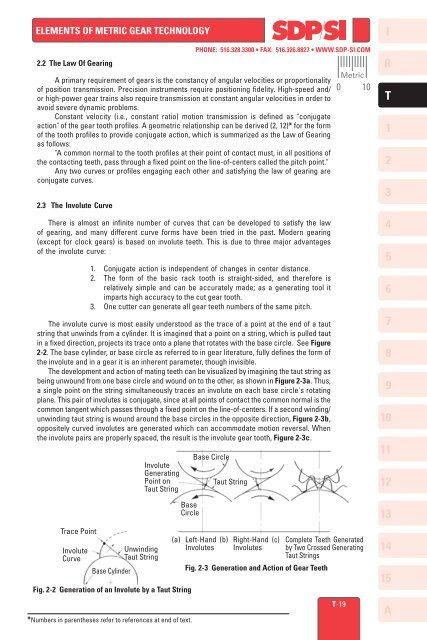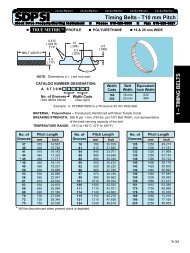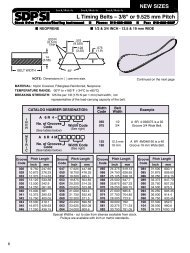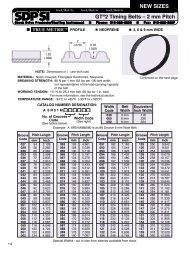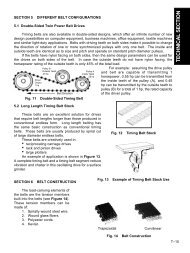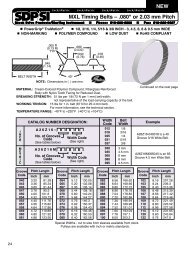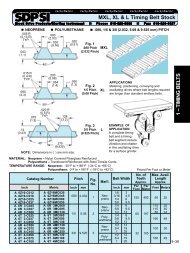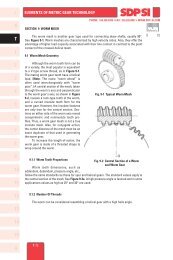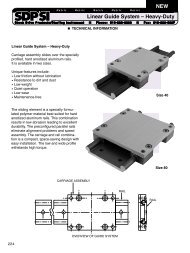I R 1 2 3 4 5 6 7 8 9 10 11 12 13 T 14 15 A - SDP/SI
I R 1 2 3 4 5 6 7 8 9 10 11 12 13 T 14 15 A - SDP/SI
I R 1 2 3 4 5 6 7 8 9 10 11 12 13 T 14 15 A - SDP/SI
Create successful ePaper yourself
Turn your PDF publications into a flip-book with our unique Google optimized e-Paper software.
ELEMENTS OF METRIC GEAR TECHNOLOGY<br />
2.2 The Law Of Gearing<br />
PHONE: 516.328.3300 • FAX: 516.326.8827 • WWW.<strong>SDP</strong>-<strong>SI</strong>.COM<br />
A primary requirement of gears is the constancy of angular velocities or proportionality<br />
of position transmission. Precision instruments require positioning fidelity. High-speed and/<br />
or high-power gear trains also require transmission at constant angular velocities in order to<br />
avoid severe dynamic problems.<br />
Constant velocity (i.e., constant ratio) motion transmission is defined as "conjugate<br />
action" of the gear tooth profiles. A geometric relationship can be derived (2, <strong>12</strong>)* for the form<br />
of the tooth profiles to provide conjugate action, which is summarized as the Law of Gearing<br />
as follows:<br />
"A common normal to the tooth profiles at their point of contact must, in all positions of<br />
the contacting teeth, pass through a fixed point on the line-of-centers called the pitch point."<br />
Any two curves or profiles engaging each other and satisfying the law of gearing are<br />
conjugate curves.<br />
2.3 The Involute Curve<br />
There is almost an infinite number of curves that can be developed to satisfy the law<br />
of gearing, and many different curve forms have been tried in the past. Modern gearing<br />
(except for clock gears) is based on involute teeth. This is due to three major advantages<br />
of the involute curve:<br />
1. Conjugate action is independent of changes in center distance.<br />
2. The form of the basic rack tooth is straight-sided, and therefore is<br />
relatively simple and can be accurately made; as a generating tool it<br />
imparts high accuracy to the cut gear tooth.<br />
3. One cutter can generate all gear teeth numbers of the same pitch.<br />
The involute curve is most easily understood as the trace of a point at the end of a taut<br />
string that unwinds from a cylinder. It is imagined that a point on a string, which is pulled taut<br />
in a fixed direction, projects its trace onto a plane that rotates with the base circle. See Figure<br />
2-2. The base cylinder, or base circle as referred to in gear literature, fully defines the form of<br />
the involute and in a gear it is an inherent parameter, though invisible.<br />
The development and action of mating teeth can be visualized by imagining the taut string as<br />
being unwound from one base circle and wound on to the other, as shown in Figure 2-3a. Thus,<br />
a single point on the string simultaneously traces an involute on each base circle's rotating<br />
plane. This pair of involutes is conjugate, since at all points of contact the common normal is the<br />
common tangent which passes through a fixed point on the line-of-centers. If a second winding/<br />
unwinding taut string is wound around the base circles in the opposite direction, Figure 2-3b,<br />
oppositely curved involutes are generated which can accommodate motion reversal. When<br />
the involute pairs are properly spaced, the result is the involute gear tooth, Figure 2-3c.<br />
Trace Point<br />
Involute<br />
Curve<br />
Base Cylinder<br />
Unwinding<br />
Taut String<br />
Involute<br />
Generating<br />
Point on<br />
Taut String<br />
Base<br />
Circle<br />
Fig. 2-2 Generation of an Involute by a Taut String<br />
*Numbers in parentheses refer to references at end of text.<br />
Base Circle<br />
(a) Left-Hand<br />
Involutes<br />
Taut String<br />
(b) Right-Hand (c) Complete Teeth Generated<br />
Involutes by Two Crossed Generating<br />
Taut Strings<br />
Fig. 2-3 Generation and Action of Gear Teeth<br />
Metric<br />
0 <strong>10</strong><br />
T-19<br />
I<br />
R<br />
T<br />
1<br />
2<br />
3<br />
4<br />
5<br />
6<br />
7<br />
8<br />
9<br />
<strong>10</strong><br />
<strong>11</strong><br />
<strong>12</strong><br />
<strong>13</strong><br />
<strong>14</strong><br />
<strong>15</strong><br />
A


